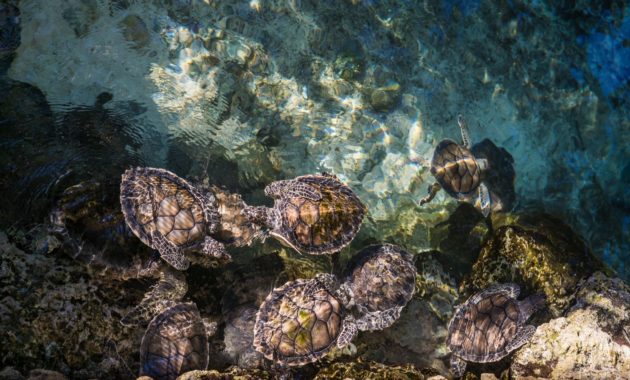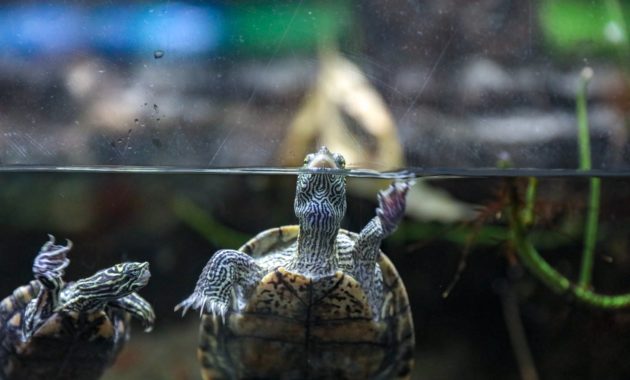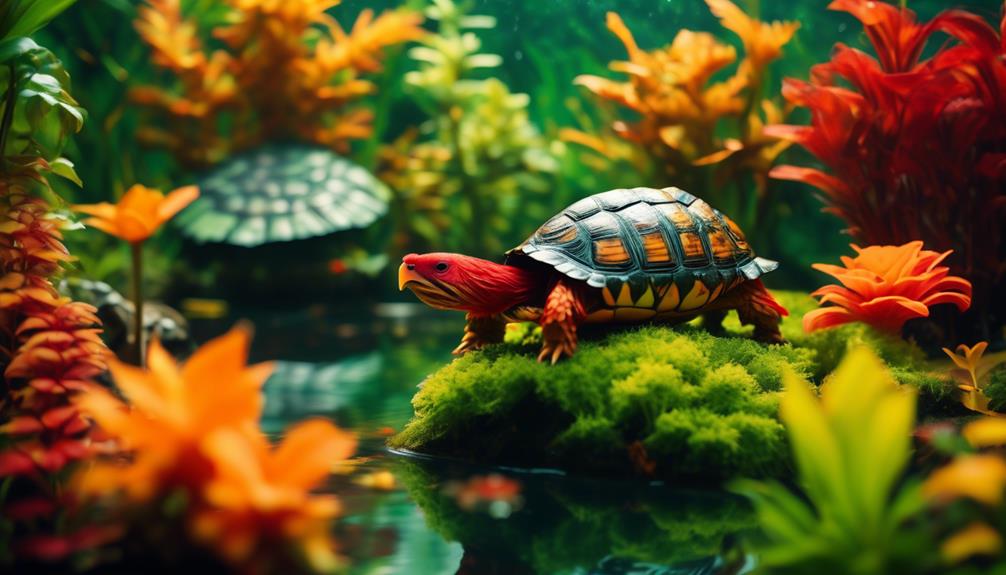
In the vast tapestry of the reptile kingdom, chicken turtles emerge as a vivid splash of color amidst a sea of muted hues. Their vibrant shells, adorned with captivating rings of yellow and green, serve as a metaphor for the kaleidoscope of wonders awaiting those who venture into their world.
But what lies beneath these colorful exteriors? What secrets do these unique creatures hold?
Join us as we peel back the layers and uncover the fascinating world of chicken turtles, from their diverse species to their distinct habitat and care requirements.
Prepare to be captivated as we embark on a journey that will leave you yearning for more.
Key Takeaways
- There are three species of Chicken Turtles: Eastern, Florida, and Western.
- Chicken Turtles have variations in shell color, often with yellow and green rings.
- They are native to the southeastern United States and prefer habitats with soft substrate and vegetation.
- Chicken Turtles require specific indoor and outdoor enclosures, a varied diet, and can be kept with other non-aggressive turtle breeds.
Chicken Turtle Species and Variations
There are three species of Chicken Turtles, each displaying unique variations in their shell patterns and colors.
The Eastern Chicken Turtle has a duller color, with brown or green lines on its carapace and black markings on its underside. It also has a narrow band of color on the rim of its carapace.
The Florida Chicken Turtle, on the other hand, has broad yellow or orange lines on its carapace, a wide band of color on the carapace rim, and no markings on its plastron.
Lastly, the Western Chicken Turtle has faint, broad lines on its carapace and dark markings on its plastron seams.
These variations in color and patterns make each species of Chicken Turtle unique and visually appealing.
Native Habitat and Preferred Environments

After discussing the variations in shell patterns and colors among the different species of Chicken Turtles, it is important to explore their native habitat and preferred environments. Chicken Turtles are native to a wide range of areas, from Virginia to Florida, and westward to Missouri, Texas, and Oklahoma. They prefer habitats such as lakes, swamps, and ponds with soft substrate and vegetation. To provide a better understanding of their native habitat and preferred environments, the following table highlights their specific requirements:
| Native Habitat and Preferred Environments | |
|---|---|
| Native Range | Virginia to Florida, westward to Missouri, Texas, and Oklahoma |
| Habitat Preference | Lakes, swamps, ponds with soft substrate and vegetation |
| Indoor Enclosure Requirements | Large tub or tank with water filtration system, UVB light, warm basking area, underwater and floating plants, driftwood |
| Outdoor Enclosure Requirements | Outdoor pond with hibernation area, 2/3 water depth, soft substrate, air temperature mid 70s to 80s Fahrenheit, basking area heated to 85-90F, water temperature mid 70s Fahrenheit for adults |
Understanding the native habitat and preferred environments of Chicken Turtles is crucial for providing them with appropriate care and ensuring their well-being.
Color Variations and Physical Characteristics
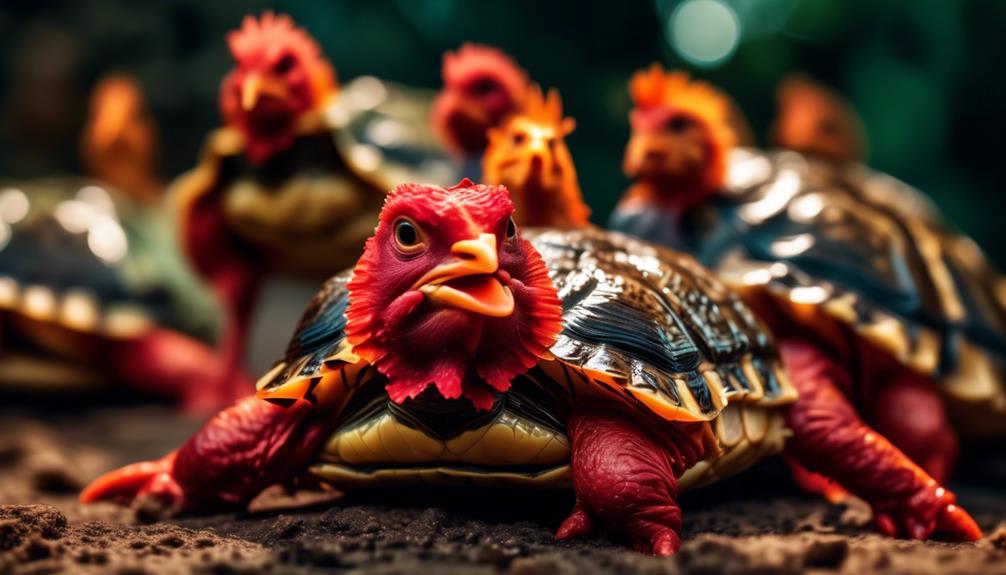
Chicken Turtles exhibit a range of vibrant colors and distinctive physical characteristics. The shell of the Eastern Chicken Turtle often has duller colors with brown or green lines on the carapace, black markings on the underside, and a narrow band of color on the carapace rim.
On the other hand, the Florida Chicken Turtle has broad yellow or orange lines on the carapace, a wide band of color on the carapace rim, and no markings on the plastron.
The Western Chicken Turtle has faint, broad lines on the carapace and dark markings on the plastron seams.
In addition to their colorful shells, Chicken Turtles have large eyes, long and striped necks, a pear-shaped carapace, and webbed feet. These physical characteristics make them unique and fascinating creatures to observe.
Indoor and Outdoor Care Requirements

Indoor and outdoor care requirements are essential for ensuring the health and well-being of Chicken Turtles, which exhibit a range of vibrant colors and distinctive physical characteristics. To provide the best care for these fascinating creatures, here are the key requirements:
- Indoor enclosure: A large tub or tank with a water filtration system is necessary. It should have a UVB light for proper vitamin D synthesis, a warm basking area, and underwater and floating plants for enrichment. Driftwood can also be added for climbing and hiding.
- Outdoor enclosure: An outdoor pond with a hibernation area is ideal. The water depth should be two-thirds of the enclosure, with soft substrate for digging. The air temperature should be in the mid 70s to 80s Fahrenheit, while the basking area should be heated to 85-90F. Water temperature should be in the mid 70s Fahrenheit for adult turtles.
- Hatchlings' diet: Tadpoles, crayfish, and aquatic insects should be provided. As they grow, their diet should include a mix of commercial pelleted diet, invertebrates, fish, non-toxic aquatic plants, and leafy greens.
- Compatibility: Chicken Turtles can be kept with other non-aggressive turtle breeds, but care should be taken to avoid competition for food, which may lead to injuries.
Hatchlings' Diet and Adult Omnivorous Diet
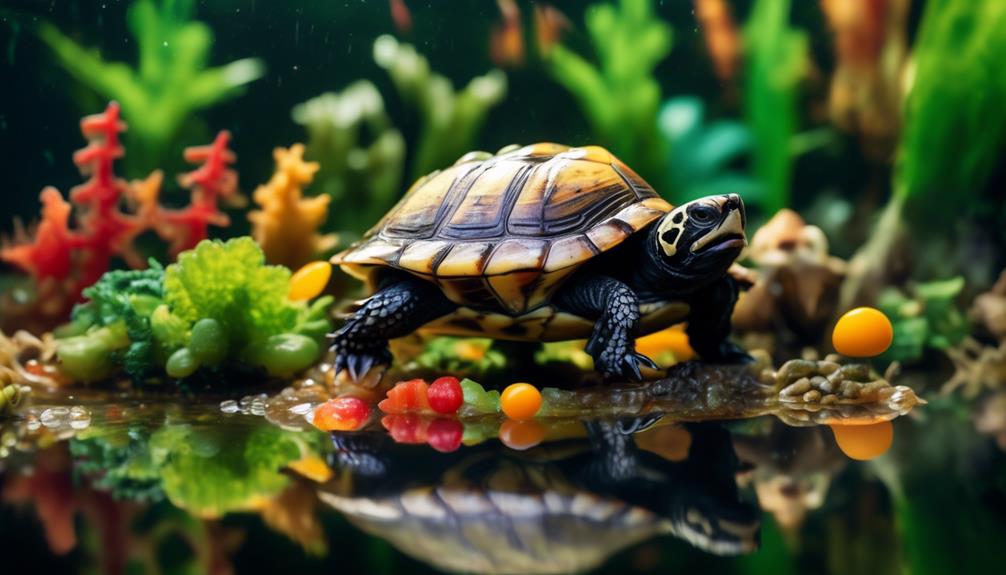
To ensure their proper growth and nutrition, Chicken Turtle hatchlings and adult turtles require a varied and balanced diet. Hatchlings primarily eat tadpoles, crayfish, and aquatic insects. As they grow, their diet becomes omnivorous, consisting of a commercial pelleted diet, invertebrates, fish, non-toxic aquatic plants, and leafy greens.
It's important to provide a mix of protein, vitamins, and minerals to support their development and overall health. While Chicken Turtles can be kept with other non-aggressive turtle breeds, it's essential to ensure that there's no competition for food, as this may lead to injuries.
Social Behavior and Taming Chicken Turtles
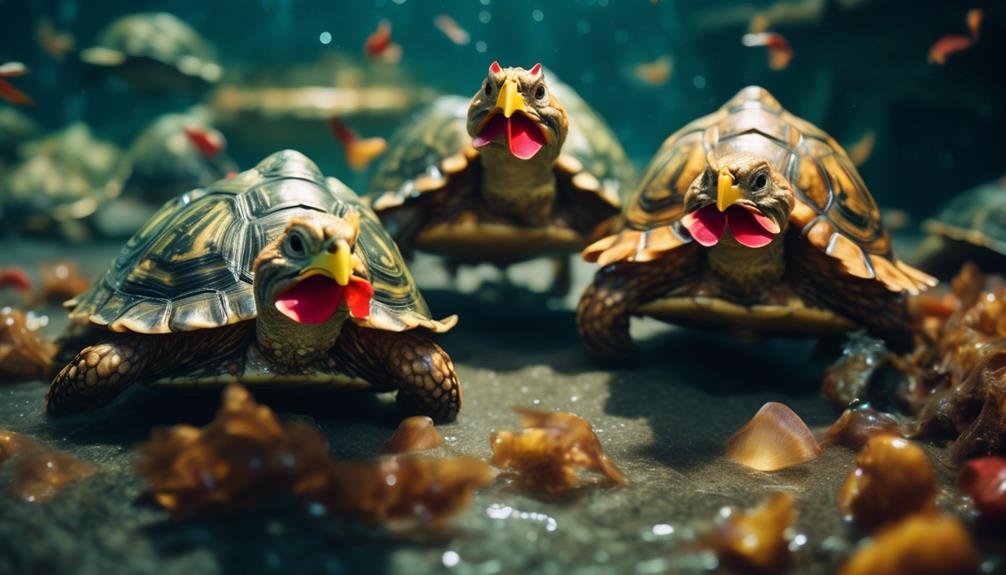
When kept in the same enclosure, Chicken Turtles display social behavior and gradually become more comfortable with human interaction.
Here are some key points about their social behavior and taming process:
- Social behavior: Chicken Turtles can be kept together in the same enclosure, allowing them to interact and form social bonds. They're alert but shy, often diving into the water when approached while basking.
- Taming process: With time and patience, Chicken Turtles can become tame and more comfortable with human presence. They'll eventually come to the surface for food, showing trust and familiarity.
- Bonding with owners: By consistently providing food and positive interactions, Chicken Turtles can develop a bond with their owners. They'll recognize and respond to their caregivers, making the taming process rewarding for both parties.
- Individual temperament: It's important to remember that each Chicken Turtle has its own unique temperament. Some may become more sociable and tame quicker than others, while some may take longer to adjust. Patience and understanding are key in building a trusting relationship with these colorful turtles.
Comparisons With Other Turtle Breeds

Chicken Turtles can be compared to other turtle breeds in terms of their size, lifespan, and dietary requirements. One comparable breed is the Eastern Painted Turtle, which has a similar lifespan of 18-24 years. In terms of size, Chicken Turtles are small and their length can vary. Both Chicken Turtles and Eastern Painted Turtles are semi-aquatic, meaning they spend time both in water and on land. When it comes to diet, Chicken Turtles and Eastern Painted Turtles have similar requirements, including a diet of commercial pelleted food, invertebrates, leafy green vegetables, and non-toxic aquatic plants. To summarize the comparisons, the table below provides a visual representation:
| Breed | Lifespan | Size | Diet |
|---|---|---|---|
| Chicken Turtle | 18-24 years | Small, varies | Pellets, invertebrates, leafy greens, plants |
| Eastern Painted Turtle | 18-24 years | Small, varies | Pellets, invertebrates, leafy greens, plants |
Frequently Asked Questions
Are Chicken Turtles Good Pets for Beginners?
Chicken turtles can be good pets for beginners. They have a small size, are semi-aquatic, and have an omnivorous diet. They require specific care requirements such as a large enclosure with water filtration system, UVB light, and warm basking area.
How Often Do Chicken Turtles Need to Bask in the Sun?
Chicken turtles need to bask in the sun regularly for their overall health and well-being. They should be provided with a warm basking area in their enclosure where they can soak up the sun's rays.
Can Chicken Turtles Live in a Small Tank?
Chicken turtles cannot live in a small tank as they require a large enclosure with a water filtration system, UVB light, warm basking area, and underwater and floating plants. They also need ample space to swim and explore.
What Is the Average Size of a Chicken Turtle?
The average size of a chicken turtle varies depending on the species. Eastern chicken turtles typically grow to be around 5-7 inches in length, while Florida and Western chicken turtles can reach lengths of up to 10 inches.
Do Chicken Turtles Hibernate During the Winter?
Yes, chicken turtles do hibernate during the winter. They require an outdoor pond with a hibernation area and a water depth of 2/3 of the enclosure. The air temperature should be in the mid 70s to 80s Fahrenheit.
What Makes Chicken Turtles Different from Western Painted Turtles?
Chicken turtles are often mistaken for the colorful Western painted turtle due to their similar appearances. However, there are differences that set them apart. For instance, chicken turtles have distinct yellow stripes on their heads and necks, while the Western painted turtles have brighter and bolder shell colors.
Conclusion
In conclusion, chicken turtles are truly a remarkable addition to the world of reptiles. With their vibrant colors, unique patterns, and captivating characteristics, they offer a colorful and captivating experience for reptile enthusiasts.
From their distinct shells to their shy yet alert behavior, chicken turtles are a sight to behold. With proper care and suitable environments, these turtles can thrive and become a cherished part of any collection.
So, dive into the colorful world of chicken turtles and discover the wonders they have to offer.


